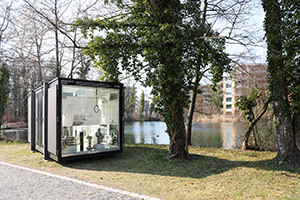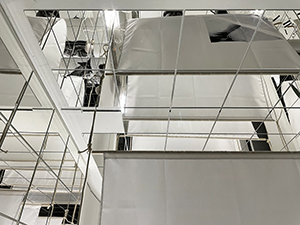
When a whale is a lake, its surface reflects deep time
Wenn ein Wal ein See ist, spiegelt sich in seiner Oberfläche die tiefe Zeit
Personal exhibition
Kunstkiste N° 47, Akku Uster, at Zellwegerpark in Uster
Installation, actively working with metaphors and displaced techniques between the image and imaginary, fiction and facts, materials and abstraction. It forms an assemblage of mirror surface, prints on fabric, hand-built and cast sculptural ceramic objects in environmental dialog with its location at Zellweger-Park in Uster.
Installation and detail views of When a whale is a lake, its surface reflects deep time, personal exhibition by Dimitrina Sevova, Kunstkiste N° 47, Akku Uster, at Zellwegerpark in Uster. Photos courtesy of the artist
The Greifensee as a Whale
The artist, born on the shore of the Black Sea in Varna, developed an attachment to the sea. Her father, a Bulgarian poet and writer, kept a few books on his bedside table. Having asked him, before she was able to read, about one of these, a heavy tome by Herman Melville that included Moby Dick, she was told that he could not yet read it to her and she needed to grow up a bit and read it herself. This book, one of his literary north stars, took on the role of the writer’s bible.
The artist takes as a starting point for her exhibition at Kunstkiste this childhood experience and connects it with her Förderstipendium at Akku Uster and the shape of Greifensee seen from above, mapped out as a whale.
Did Captain Ahab love the great white whale as obsessively as he hated him? What did he see during the endless hours staring at the surface of the unfathomable body of water carrying his ship? Or just beneath it? In the General Secretary's Report to the International Necronautical Society (INS) titled “Navigation Was Always a Difficult Art”, Tom McCarthy and Simon Critchley focus on Queequeg instead, the Polynesian harpooner, who, despite already having built his coffin from Nantucket wood decides not to die, after all. The manifesto recounts how, in the novel, the coffin’s dark wood colour reminds Queequeg of the trees of his native island. Similarly, the Nantucket custom of setting dead whalers adrift in small boats felt familiar to him, “for it was not unlike the custom of his own race, who, after embalming a dead warrior, stretched him out in his canoe, and so left him to be floated away to the starry archipelagos; for not only do they believe that the stars are isles, but that far beyond all visible horizons, their own mild, uncontinented seas, interflow with the blue heavens; and so form the white breakers of the milky way.”
Under the surface of the Greifensee, just beneath the skin of this watery whale, we find a zone of interconnectedness, of confluence. Seen through an artist’s eye, there are forms to be found, ever-changing, restless, stars and islands and creatures. These forms mirror the happenings above, they interflow with the surrounding territories and skies, the dark ecology of the pattern of industrious, human production that opens up new ways of living with nature. The great whale lies there and waits, longing to be found.
Der Greifensee als Wal
Die am Schwarzen Meer in Varna geborene Künstlerin entwickelte eine enge Beziehung zum Meer. Ihr Vater, ein bulgarischer Dichter und Schriftsteller, bewahrte einige Bücher auf seinem Nachttisch auf. Als sie ihn, noch bevor sie lesen konnte, nach einem dieser Bücher fragte, einem dicken Wälzer von Herman Melville, der auch Moby Dick enthielt, sagte er ihr, dass er ihn ihr noch nicht vorlesen könne und sie zuerst etwas älter werden und ihn dann selbst lesen müsse. Dieses Buch war eines seiner literarischen Nordsterne und nahm die Rolle der Schriftstellerbibel ein.
Die Künstlerin nimmt dieses Kindheitserlebnis als Ausgangspunkt für ihre Ausstellung in der Kunstkiste und verbindet es mit ihrem Förderstipendium im Akku Uster und der Form des Greifensees aus der Vogelperspektive, der wie ein Wal kartiert.
Hat Kapitän Ahab den grossen weissen Wal so obsessiv geliebt, wie er ihn gehasst hat? Was sah er in den endlosen Stunden, in denen er auf die Oberfläche des unergründlichen Gewässers starrte, das sein Schiff trug? Oder unmittelbar darunter? Im Bericht des Generalsekretärs an die Internationale Nekronautische Gesellschaft (INS) mit dem Titel «Navigation war schon immer eine schwierige Kunst» konzentrieren sich Tom McCarthy und Simon Critchley stattdessen auf Queequeg, den polynesischen Harpunier, der, obwohl er seinen Sarg bereits aus Nantucket-Holz gezimmert hat, beschliesst, doch nicht zu sterben. Das Manifest erzählt, wie im Roman die dunkle Holzfarbe des Sarges Queequeg an die Bäume seiner Heimatinsel erinnert. Auch der Brauch in Nantucket, tote Walfänger in kleinen Booten aufs Meer treiben zu lassen, kam ihm bekannt vor, «fast genauso wäre die Sitte seines eigenen Stammes, der einen toten Krieger einbalsamierte, ihn darauf in sein Kanu legte und in die sternbedeckte Inselwelt hinaustreiben liess. Sie haben nämlich den Glauben, dass die Sterne Inseln sind und dass in der Ferne jenseits der Horizonte die milden Meere, in denen es kein Festland gibt, mit dem blauen Himmel zusammenfliessen und so die weissen Brecher der Milchstrasse bilden.»
Unter der Oberfläche des Greifensees, direkt unter der Haut dieses wässrigen Wals, finden wir eine Zone der Verbundenheit, des Zusammenfliessens. Mit dem Auge einer Künstlerin betrachtet, sind dort Formen zu finden, die sich ständig verändern, unruhig sind; Sterne und Inseln und Kreaturen. Diese Formen spiegeln das Geschehen über ihnen wider, sie vermischen sich mit den umliegenden Gebieten und dem Himmel, der dunklen Ökologie des Musters emsiger menschlicher Produktion, die neue Wege des Lebens mit der Natur eröffnet. Der grosse Wal liegt da und harrt darauf, gefunden zu werden.
The artist Dimitrina Sevova made a new installation especially for Kunstkiste, actively working with metaphors and displaced techniques between the image and imaginary, fiction and facts, materials and abstraction. It forms an assemblage of mirror surface, fabric, and sculptural ceramic objects in environmental dialog with its location at Zellweger-Park in Uster.
Die Künstlerin Dimitrina Sevova hat eigens für die Kunstkiste eine neue Installation geschaffen, die aktiv mit Metaphern und Verschiebetechniken zwischen Bild und Imaginärem, Fiktion und Fakten, Material und Abstraktion arbeitet. Sie bildet eine Assemblage aus Spiegelflächen, Stoff und skulpturalen Keramikobjekten im Umweltdialog mit ihrem Standort im Zellweger-Park in Uster.
Documentation of the installation on Instagram.
Dokumentation der Installation auf Instagram.











